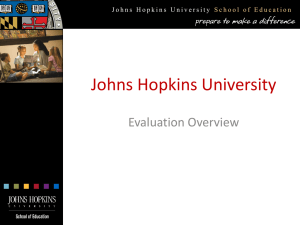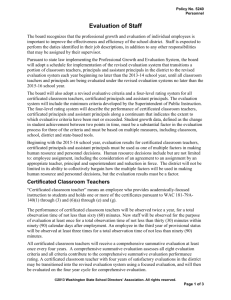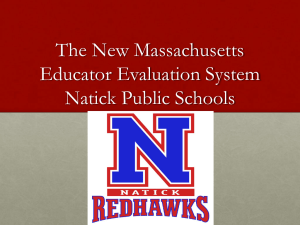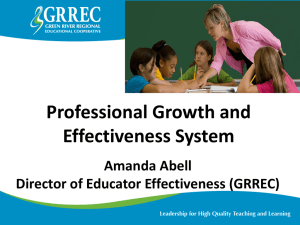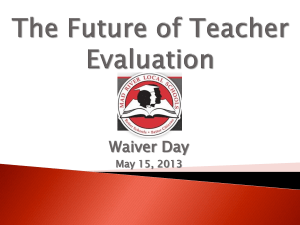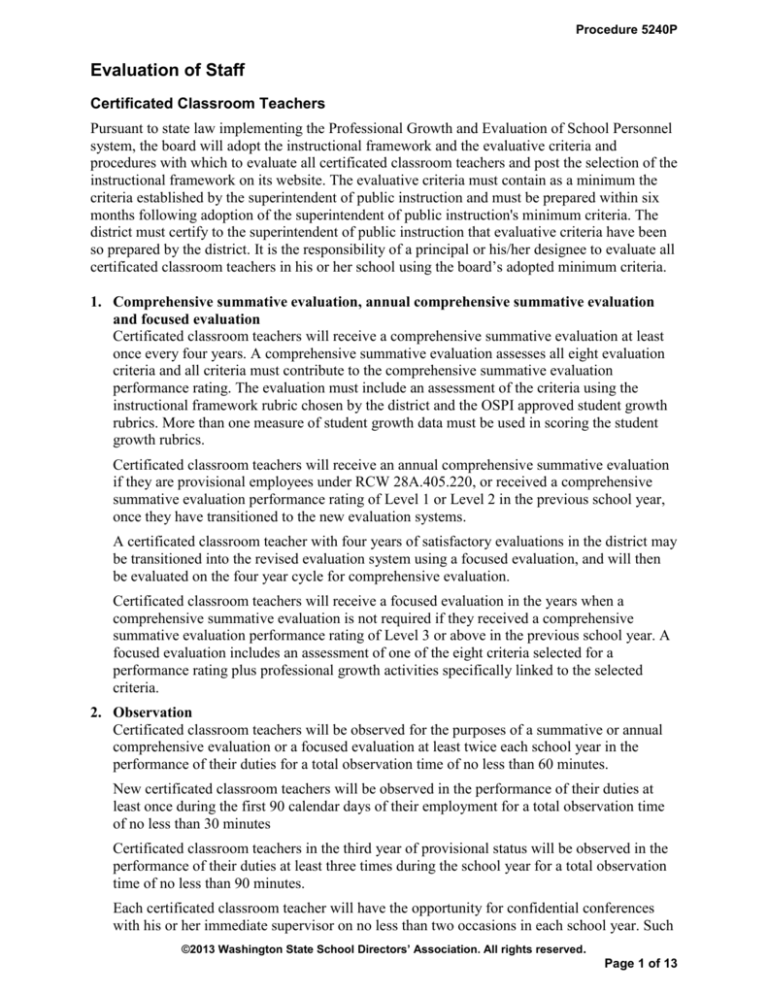
Procedure 5240P
Evaluation of Staff
Certificated Classroom Teachers
Pursuant to state law implementing the Professional Growth and Evaluation of School Personnel
system, the board will adopt the instructional framework and the evaluative criteria and
procedures with which to evaluate all certificated classroom teachers and post the selection of the
instructional framework on its website. The evaluative criteria must contain as a minimum the
criteria established by the superintendent of public instruction and must be prepared within six
months following adoption of the superintendent of public instruction's minimum criteria. The
district must certify to the superintendent of public instruction that evaluative criteria have been
so prepared by the district. It is the responsibility of a principal or his/her designee to evaluate all
certificated classroom teachers in his or her school using the board’s adopted minimum criteria.
1. Comprehensive summative evaluation, annual comprehensive summative evaluation
and focused evaluation
Certificated classroom teachers will receive a comprehensive summative evaluation at least
once every four years. A comprehensive summative evaluation assesses all eight evaluation
criteria and all criteria must contribute to the comprehensive summative evaluation
performance rating. The evaluation must include an assessment of the criteria using the
instructional framework rubric chosen by the district and the OSPI approved student growth
rubrics. More than one measure of student growth data must be used in scoring the student
growth rubrics.
Certificated classroom teachers will receive an annual comprehensive summative evaluation
if they are provisional employees under RCW 28A.405.220, or received a comprehensive
summative evaluation performance rating of Level 1 or Level 2 in the previous school year,
once they have transitioned to the new evaluation systems.
A certificated classroom teacher with four years of satisfactory evaluations in the district may
be transitioned into the revised evaluation system using a focused evaluation, and will then
be evaluated on the four year cycle for comprehensive evaluation.
Certificated classroom teachers will receive a focused evaluation in the years when a
comprehensive summative evaluation is not required if they received a comprehensive
summative evaluation performance rating of Level 3 or above in the previous school year. A
focused evaluation includes an assessment of one of the eight criteria selected for a
performance rating plus professional growth activities specifically linked to the selected
criteria.
2. Observation
Certificated classroom teachers will be observed for the purposes of a summative or annual
comprehensive evaluation or a focused evaluation at least twice each school year in the
performance of their duties for a total observation time of no less than 60 minutes.
New certificated classroom teachers will be observed in the performance of their duties at
least once during the first 90 calendar days of their employment for a total observation time
of no less than 30 minutes
Certificated classroom teachers in the third year of provisional status will be observed in the
performance of their duties at least three times during the school year for a total observation
time of no less than 90 minutes.
Each certificated classroom teacher will have the opportunity for confidential conferences
with his or her immediate supervisor on no less than two occasions in each school year. Such
©2013 Washington State School Directors’ Association. All rights reserved.
Page 1 of 13
Procedure 5240P
confidential conference shall have as its sole purpose the aiding of the administrator in his or
her assessment of the employee's professional performance.
3. Evaluation report
The evaluator will promptly document the results of the observation or series of observations
and will, within three days, provide a copy of the evaluation report to the certificated
classroom teacher. The certificated classroom teacher will sign the district’s original
evaluation report to indicate that he/she has received a copy, although the signature does not
necessarily imply agreement with the contents of the evaluation report. The evaluator will
provide the certificated classroom teacher the opportunity to attach written comments to
his/her report, and then ensure each evaluation report is placed in that individual’s personnel
file.
4. Minimum criteria for evaluation of certificated classroom teachers:
Centering instruction on high expectations for student achievement. The related
descriptor is: Expectations; the teacher communicates high expectations for student
learning.
Demonstrating effective teaching practices. The related descriptor is: Instruction; the
teacher uses research-based instructional practices to meet the needs of all students.
Recognizing individual student learning needs and developing strategies to address those
needs. The related descriptor is: Differentiation; the teacher acquires and uses specific
knowledge about students’ cultural, individual, intellectual and social development and
uses that knowledge to adjust their practice by employing strategies that advance student
learning. Student growth data must be a substantial factor utilizing the OSPI approved
student growth rubrics.
Providing clear and intentional focus on subject matter content and curriculum. The
related descriptor is: Content knowledge; the teacher uses content area knowledge,
learning standards, appropriate pedagogy and resources to design and deliver curricula
and instruction to impact student learning.
Fostering and managing a safe, positive learning environment. The related descriptor is:
Learning environment; the teacher fosters and manages a safe an inclusive learning
environment that takes into account the physical, emotional and intellectual well-being of
students.
Using multiple student data elements to modify instruction and improve student learning.
The related descriptor is: Assessment; the teacher uses multiple data elements (both
formative and summative) to plan, inform, and adjust instruction, and evaluate student
learning. Student growth data must be a substantial factor utilizing the OSPI approved
student growth rubrics.
Communicating and collaborating with parents and school community. The related
descriptor is: Families and community; the teacher communicates and collaborates with
students, families and all educational stakeholders in an ethical and professional manner
to promote student learning.
Exhibiting collaborative and collegial practices focused on improving instructional
practice and student learning. The related descriptor is: Professional practice; the teacher
participates collaboratively in the educational community to improve instruction, advance
the knowledge and practice of teaching as a profession, and ultimately impact student
learning. Student growth data must be a substantial factor utilizing the OSPI approved
student growth rubrics.
©2013 Washington State School Directors’ Association. All rights reserved.
Page 2 of 13
Procedure 5240P
5. Analysis of evidence
The evaluator will analyze the evidence observed according to the appropriate criterion,
the instructional framework and student growth rubrics.
The evaluator will calculate all criterion scores to derive an overall summative score and
then determine the final four-level rating (summative performance rating) based on the
OSPI summative evaluation scoring band.
In evaluating certificated classroom teachers, student input may be included.
6. Summative performance ratings
Level 1: Unsatisfactory. Professional practice shows evidence of not understanding the
concepts underlying individual components of the criteria. This level of practice is
ineffective and inefficient and may represent practice that is harmful to student learning
progress, professional learning environment, or individual teaching practice. This level
requires immediate intervention.
Level 2: Basic. Professional practice shows a developing understanding of the knowledge
and skills of the criteria required to practice, but performance is inconsistent over a
period of time due to lack of experience, expertise, and/or commitment. This level may
be considered minimally competent for teachers early in their careers but insufficient for
more experienced teachers. This level requires specific support.
Level 3: Proficient. Professional practice shows evidence of thorough knowledge of all
aspects of the profession. This is successful, accomplished, professional and effective
practice. Teaching at this level utilizes a broad repertoire of strategies and activities to
support student learning. At this level, teaching is strengthened and expanded through
purposeful, collaborative sharing and learning with colleagues as well as ongoing selfreflection and professional improvement.
Level 4: Distinguished. Professional practice at is that of a master professional whose
practices operate at a qualitatively different level from those of other professional peers.
To achieve this rating, a teacher would need to have received a majority of distinguished
ratings on the criterion scores. A teacher at this level must show evidence of average to
high impact on student growth. Ongoing, reflective teaching is demonstrated through the
highest level of expertise and commitment to all students’ learning, challenging
professional growth and collaborative practice.
7. Student growth impact rating
Upon completing the overall summative scoring process, the evaluator will combine only
the student growth rubric scores to assess the student growth impact rating.
The evaluator will determine the student growth impact according to OSPI’s student
impact rating scoring band. A student growth score of ‘1’ in any of the rubric rows will
result in an overall low student growth impact rating.
The evaluators will analyze the student growth score in light of the overall summative
score and determine the outcomes.
8. Student growth rating outcomes
Certificated classroom teachers with a preliminary rating of Distinguished with low
student growth rating will receive an overall Proficient rating.
Certificated classroom teachers with a low student growth rating will engage with their
evaluator in a Student Growth Inquiry.
©2013 Washington State School Directors’ Association. All rights reserved.
Page 3 of 13
Procedure 5240P
Certificated classroom teachers with a preliminary rating of Distinguished with average
or high student growth rating will receive an overall Distinguished rating and will be
formally recognized and/or rewarded.
Evaluations of certificated classroom teachers with a preliminary rating of Unsatisfactory and
high student growth rating will be reviewed by the evaluator’s supervisor.
9. Student growth inquiry
Within two months of a certificated classroom teacher receiving a low student growth score
or at the beginning of the following school year, the evaluator will initiate one or more of the
following:
Examine student growth data in conjunction with other evidence including observation,
artifacts and other student and teacher information based on appropriate classroom,
school, district and state-based tools and practices;
Examine extenuating circumstances which may include one or more of the following:
Goal setting process; content and expectations; student attendance and extent to which
standards, curriculum and assessment are aligned;
Schedule monthly conferences focused on improving student growth to include one or
more of the following topics: Student growth goal revisions, refinement, and progress;
best practices related to instruction areas in need of attention; best practices related to
student growth data collection and interpretation;
Create and implement a professional development plan to address student growth areas.
10. Focused evaluation
Certificated classroom teachers will be observed for the purpose of focused evaluation twice
each school year for a total observation time of no less than 60 minutes.
The focused evaluation will include, at a minimum:
One of the eight criteria for certificated classroom teachers must be assessed in every
year that a comprehensive evaluation is not required.
The selected criterion must be approved by the teacher’s evaluator and may have been
identified in a previous comprehensive summative evaluation as benefiting from
additional attention.
The evaluation must include an assessment of the criterion using the instructional
framework rubrics and the OSPI approved student growth rubrics. More than one
measure of student growth date must be used in scoring student growth rubrics.
The focused evaluation will include the student growth rubrics of the selected criterion.
If criterion 3, 6, or 8 is selected, evaluators will use those student growth rubrics. If
criterion 1, 2, 4, 5 or 7 is selected, evaluators will use criterion 3 or 6 student growth
rubrics.
A summative score is calculated through the scoring of the instructional and student
growth rubrics for the criterion selected.
A certificated classroom teacher may be transferred from a focused evaluation to a
comprehensive summative evaluation at his/her request or at the direction of his/her
evaluator.
Certificated classroom teachers may apply the focused evaluation professional growth
activities toward the professional growth plan for professional certificate renewal as required
by the professional educator standards board.
©2013 Washington State School Directors’ Association. All rights reserved.
Page 4 of 13
Procedure 5240P
11. Notice of deficiency and reasonable program for improvement
At any time after October 15, a certificated classroom teacher whose work is not judged
satisfactory based on district evaluation criteria will be given a written notice of deficiency
that lists specific areas of deficiencies and provides a reasonable program for improvement.
For certificated classroom teachers who have been transitioned to the revised evaluation
system, the following summative performance ratings mean that his/her work is not judged
satisfactory:
Level 1
Level 2 if the classroom teacher is a continuing contract employee under RCW
28A.405.210 with more than five years of teaching experience and if the Level 2 rating
has been received for two consecutive years or for two years within a consecutive threeyear time period.
12. Probation
A probationary period of 60 school days will be established for those certificated classroom
teachers whose work is not judged satisfactory. This period may be extended if deemed
necessary to complete a program for improvement and evaluate the probationer’s
performance, as long as the probation period is concluded before May 15 of the same school
year. The probation period may be extended to the following school year if the probationer
has five or more years of teaching experience and a comprehensive summative evaluation
performance rating as of May 15 of Level 1.
The superintendent will establish the probationary period and provide the notice of
deficiency to the probationer. The purpose of the probation period is to give the probationer
the opportunity to demonstrate improvements in his or her area of deficiency. The
establishment of a probationary period does not adversely affect the probationer’s contract
status within the meaning of RCW 28A. 405.300.
During the period of probation, the probationer may not be transferred from the supervision
of the original evaluator. The original evaluator must document any improvement of
performance or probable cause for non-renewal before any consideration of a request for
transfer or reassignment contemplated by either the probationer or the district can occur.
During the probation period, the evaluator will meet with the probationer at least twice
monthly to supervise and make a written evaluation of progress, if any, made by the
probationer.
The evaluator may authorize one additional certificated staff member to evaluate the
probationer and to aid them in improving their area of deficiency. Should the evaluator not
authorize an additional evaluator, the probationer may request that an additional certificated
employee evaluator become part of the probationary process. This request must be
implemented by including an additional experienced evaluator assigned by the educational
service district in which the school district is located and selected from a list of evaluation
specialists compiled by the educational services district. Such additional certificated staff
members will be immune from civil liability incurred or imposed during an otherwise good
faith performance of an evaluation. Procedural errors occurring during a program for
improvement do not invalidate the effectiveness of the plan or the ability to evaluate the
probationer’s performance.
13. Removal from probation
The probationer will be removed from probation if he or she has demonstrated improvement
to the satisfaction of the evaluator in the specific areas detailed in the notice of deficiency
and in the program for improvement. Certificated classroom teachers who have been
transitioned to the revised evaluation system implemented by September 1, 2013, must be
©2013 Washington State School Directors’ Association. All rights reserved.
Page 5 of 13
Procedure 5240P
removed from probation if he or she has demonstrated improvement that results in a new
comprehensive summative evaluation performance rating of Level 2 or above for a
provisional employee or for a continuing contract employee with five or fewer years of
experience or of level 3 or above for a continuing contract employee with more than five
years of experience.
14. Lack of improvement while on probation
If a probationer does not show necessary improvement during the probation period, the
evaluator will document the lack of necessary improvement and the superintendent will
notify the probationer in writing that this constitutes grounds for a finding of probable cause
for non-renewal as provided in Policy 5280, Termination of Employment.
When a continuing contract employee with five or more years of experience receives a
comprehensive summative evaluation performance rating below Level 2 for two consecutive
years, the district will implement the employee notification of discharge within ten days of
the second summative comprehensive evaluation or May 15, whichever occurs first.
15. Alternative assignment
Immediately following the completion of the probationary period that does not produce
necessary performance changes detailed in the initial notice of deficiencies and program for
improvement, a certified classroom teacher may be removed from his or her assignment and
placed into an alternative assignment for the remainder of the school year
A certificated classroom teacher who has been transitioned to the revised evaluation system
may be removed from his or her assignment and placed into an alternative assignment for the
remainder of the school year immediately following the completion of a probationary period
that does not result in the required comprehensive summative evaluation performance rating
of Level 2 or above for a provisional employee or a continuing contract employee with five
or fewer years of experience or of Level 3 or above for a continuing contract employee with
more than five years of experience. The alternative assignment may not displace another staff
member or adversely affect the certified classroom teacher’s compensation or benefits for the
remainder of the contract year. In the event such alternative assignment is not possible, the
district may place the staff person on paid leave for the balance of the contract term.
16. Notification of discharge
If a contract employee with five or more years of experience receives a comprehensive
summative evaluation performance rating below Level 2 for two consecutive years, the
district will, within 10 days of completion of the second evaluation or by May 15, whichever
occurs first, implement the employee notification of discharge as provided in RCW
28A.405.300 and Policy 5280, Termination of Employment.
Evaluation of Certificated Principals and Assistant Principals
Pursuant to state law implementing the Professional Growth and Evaluation of School Personnel
system, the board will adopt the leadership framework and the evaluative criteria and procedures
with which to evaluate all certificated principals and assistant principals and post the selection of
the leadership framework on its website. It is the responsibility of the superintendent or his or her
designee to evaluate certificated principals and assistant principals using the board adopted
leadership framework.
1. Comprehensive summative evaluation, annual comprehensive summative evaluation
and focused evaluation
Due to the importance of instructional leadership and assuring rater agreement among
evaluators, particularly those evaluating teacher performance, school districts are encouraged
©2013 Washington State School Directors’ Association. All rights reserved.
Page 6 of 13
Procedure 5240P
to conduct comprehensive summative evaluation of principal performance on an annual
basis.
All principals will receive a comprehensive summative evaluation at least once every four
years. A comprehensive summative evaluation assesses all eight evaluation criteria
applicable to that principal and all criteria contribute to the comprehensive summative
evaluation performance rating.
Principals will receive an annual comprehensive summative evaluation if they:
Are in their first three consecutive school years of employment as a principal;
Were previously employed as a principal by another school district in the state of
Washington for three or more consecutive school years and are in the first full year as a
principal in the school district; or
Received a comprehensive summative evaluation performance rating of Level 1 or 2 in
the previous school year
In the years when a comprehensive summative evaluation is not required, principals who
received a comprehensive summative evaluation performance rating of Level 3 or above in
the previous school year will receive a focused evaluation. A focused evaluation includes an
assessment of one of the eight criteria selected for a performance rating plus professional
growth activities specifically linked to the selected criteria.
In any given year the principal or the supervisor may elect to conduct a comprehensive
summative evaluation to be used as a basis for determining that a staff member’s work is
unsatisfactory or to serve as the basis for determining that there is probable cause for nonrenewal, unless the locally bargained evaluation process provides otherwise.
2. Minimum criteria for evaluation of principals and assistant principals:
Evaluation of principals and assistant principals will be based on the administrative position
job description and the following minimum criteria:
Creating a school culture that promotes the ongoing improvement of learning and
teaching for students and staff. The related descriptor is: An effective leader advocates,
nurtures and sustains a school culture and instructional program that promotes student
learning and staff professional growth.
Demonstrating commitment to closing the achievement gap. The related descriptor is: An
effective leader has a commitment to closing identified gaps in achievement between
groups of students, monitoring subgroup data and developing and encouraging strategies
to eliminate those gaps. Student growth data must be a substantial factor utilizing the
OSPI approved student growth rubrics.
Providing for school safety. The related descriptor is: An effective leader teams with the
school’s community to develop routines and expectations that create a physically and
emotionally safe learning environment.
Leading the development, implementation and evaluation of a data-driven plan for
increasing student achievement, including the use of multiple student data elements. The
related descriptor is: An effective leader relies on data to promote improvement through
school improvement plans in all aspects of the school and across all of the eight principal
evaluation criteria. Student growth data must be a substantial factor utilizing the OSPI
approved student growth rubrics.
Assisting instructional staff with alignment of curriculum, instruction, and assessment
with state and local school district learning goals. The related descriptor is: An effective
©2013 Washington State School Directors’ Association. All rights reserved.
Page 7 of 13
Procedure 5240P
leader assumes responsibility to assist staff with the alignment of their teaching and
classroom assessments with the state’s learning goals and the school district’s curriculum.
Monitoring, assisting and evaluating effective instruction and assessment practices. The
related descriptor is: An effective leader monitors teaching and uses the evaluation
process and other strategies to support teachers’ efforts to strengthen their teaching and
learning in classrooms. Student growth data must be a substantial factor utilizing the
OSPI approved student growth rubrics.
Managing both staff and fiscal resources to support student achievement and legal
responsibilities. The related descriptor is: An effective leader manages human and fiscal
resources in ways that enhance the likelihood that students will thrive and succeed in
achieving the school’s goals for them.
Partnering with the school community to promote student learning. The related descriptor
is: An effective leader engages families and the community in ways that increase the
success of students.
3. Analysis of evidence
The evaluator will analyze the evidence observed according to all eight criteria, the
leadership framework rubric and the OSPI approved student growth rubrics. More than
one measure of student growth data must be used in scoring the student growth rubrics.
Input from building staff may be included in the analysis.
The evaluator will calculate all criterion scores to derive an overall summative score and
then determine the final four-level rating (summative performance rating) based on the
OSPI-determined summative evaluation scoring band.
Upon completing the overall summative scoring process, the evaluator will combine only
the student growth rubric scores to assess the principal’s student growth impact rating.
The student growth impact rating will be determined by OSPI’s student impact rating
scoring band.
A student growth score of “1” in any of the rubric rows will result in an overall low
student growth impact rating.
4. Summative performance ratings
Level 1: Unsatisfactory. Professional practice shows evidence of not understanding the
concepts underlying individual components of the criteria. This level of practice is
ineffective and inefficient and may represent practice that is harmful to student learning
progress, professional learning environment, or individual leading practice. This level
requires immediate intervention.
Level 2: Basic. Professional practice shows a developing understanding of the
knowledge and skills of the criteria required to practice, but performance is inconsistent
over a period of time due to lack of experience, expertise, and/or commitment. This level
may be considered minimally competent for principals early in their careers but
insufficient for more experienced principals. This level requires specific support.
Level 3: Proficient. Professional practice at shows evidence of thorough knowledge of all
aspects of the profession. This is successful, accomplished, professional and effective
practice. Leading at this level utilizes a broad repertoire of strategies and activities to
support student learning. At this level, leading a school is strengthened and expanded
through purposeful, collaborative sharing and learning with colleagues as well as ongoing
self-reflection and professional improvement.
©2013 Washington State School Directors’ Association. All rights reserved.
Page 8 of 13
Procedure 5240P
Level 4: Distinguished. Professional practice is that of a master professional whose
practices operate at a qualitatively different level from those of other professional peers.
To achieve this rating, a principal would need to have received a majority of
distinguished ratings on the criterion scores. A principal at this level must show evidence
of average to high impact on student growth. Ongoing, reflective leading is demonstrated
through the highest level of expertise and commitment to all students’ learning,
challenging professional growth and collaborative practice.
5. Student growth rating outcomes
Principals with a preliminary rating of Distinguished with low student growth rating will
receive an overall Proficient rating.
Principals with a low student growth rating will engage with their evaluator in a Student
Growth Inquiry focused on specific areas of weak student impact.
Principals with a preliminary rating of Distinguished with average or high student growth
rating will receive an overall Distinguished rating and will be formally recognized and/or
rewarded.
Evaluations of principals with a preliminary rating of Unsatisfactory and high student
growth rating will be reviewed by the evaluator’s supervisor.
6. Comprehensive summative performance ratings
For principals who have been transitioned to the revised evaluation system, the following
comprehensive summative evaluation performance ratings mean a principal’s work is not
judged satisfactory:
Level 1
Level 2 if the principal has more than five years of experience in the principal role and if
the Level 2 comprehensive summative evaluation performance rating has been received
for two consecutive years or for two years within a consecutive three-year period.
7. Student growth inquiry
Within two months of a principal receiving a low student growth score or at the beginning of
the following school year, the evaluator will initiate one or more of the following:
Examine student growth data in conjunction with other evidence including observation,
artifacts and other student and teacher information based on appropriate classroom,
school, district and state-based tools and practices;
Examine extenuating circumstances which may include one or more of the following:
Goal setting process; content and expectations; student attendance; extent to which
standards, curriculum and assessment are aligned;
Schedule monthly conferences focused on improving student growth to include one or
more of the following topics: Student growth goal revisions, refinement, and progress;
best practices related to instruction areas in need of attention; best practices related to
student growth data collection and interpretation;
Create and implement a professional development plan to address student growth areas.
8. Focused evaluation
A focused evaluation of a principal will include the following:
Assessment of one of the eight criteria for principals in every year that a comprehensive
evaluation is not required.
The selected criterion must be approved by the principal’s evaluator and may have been
identified in a previous comprehensive summative evaluation as benefiting from
additional attention.
©2013 Washington State School Directors’ Association. All rights reserved.
Page 9 of 13
Procedure 5240P
The evaluation must include an assessment of the criterion using the leadership
framework rubrics and the OSPI approved student growth rubrics. More than one
measure of student growth date must be used in scoring student growth rubrics.
The student growth rubrics selected by the principal and approved by the principal’s
evaluator.
A summative score determined through scoring of the leadership and student growth
rubrics for the criterion selected.
A principal may be transferred from a focused evaluation to a comprehensive summative
evaluation at his/her request or at the direction of his/her evaluator.
Principals may apply the focused evaluation professional growth activities toward the
professional growth plan for professional certificate renewal as required by the professional
educator standards board.
9. Notice of deficiency and reasonable program for improvement
At any time after October 15, a principal whose work is not judged satisfactory based on
district evaluation criteria will be given a written notice of deficiency that lists specific areas
of deficiencies and provides a reasonable program for improvement.
Evaluation of Certificated Support Personnel
The board will establish evaluative criteria and procedures for all certificated support personnel.
The evaluative criteria must contain as a minimum the criteria established by the superintendent
of public instruction pursuant to this section and must be prepared within six months following
adoption of the superintendent of public instruction's minimum criteria. The district must certify
to the superintendent of public instruction that evaluative criteria have been so prepared by the
district.
1. Observation
Certificated support personnel will be observed in the performance of their duties at least
twice each school year. At least one observation will be for no less than 30 minutes. Total
observation time for each employee for each school year will not be less than 60 minutes.
Prior to being transitioned to the new evaluation system, a certificated support person who
has four years of satisfactory evaluations in the district may be evaluated using a short form
evaluation pursuant to RCW 28A.405.100(11). However, after being transitioned to the new
evaluation system, these employees must be evaluated using either a focused or
comprehensive evaluation.
New employees will be observed in the performance of their duties at least once during the
first 90 calendar days of their employment for a total observation time of no less than 30
minutes.
Employees in the third year of provisional status will be observed in the performance of their
duties at least three times during the school year for a total observation time of no less than
90 minutes.
Each certificated support personnel shall have the opportunity for confidential conferences
with his or her immediate supervisor on no less than two occasions in each school year. Such
confidential conference shall have as its sole purpose the aiding of the administrator in his or
her assessment of the employee's professional performance.
©2013 Washington State School Directors’ Association. All rights reserved.
Page 10 of 13
Procedure 5240P
2. Minimum criteria for evaluation of certificated support personnel:
Knowledge and scholarship in special field: The certificated support person demonstrates
a depth and breadth of theory and content in his/her specialized field. He/she
demonstrates an understanding of and knowledge about common school education, and
demonstrates the ability to integrate the area of specialty into the school environment.
Specialized skills: The certificated support person demonstrates a competent level of skill
and knowledge in designing and conducting specialized programs of prevention,
intervention, remediation and evaluation.
Management of special and technical environment: The certificated support person
demonstrates an acceptable level of performance in managing and organizing the special
materials, equipment and environment essential to the specialized programs.
Professionalism: The certificated support person demonstrates awareness of his/her
limitations and strengths and demonstrates continued professional growth.
Involvement in assisting students, parents and staff: The certificated support person
demonstrates an acceptable level of performance in identifying those needing specialized
programs.
3. Evaluation report
The evaluator will promptly document the results of the observation or series of observations
and will, within three days, provide a copy of the evaluation report to the certificated support
personnel. The certificated support personnel will sign the district’s original evaluation report
to indicate that he/she has received a copy, although the signature does not necessarily imply
agreement with the contents of the evaluation report. The evaluator will provide the
certificated support personnel the opportunity to attach written comments to his/her report,
and then ensure each evaluation report is placed in that individual’s personnel file.
4. Evaluation results for certificated support personnel
Evaluation results for certificated support personnel will be used to:
Acknowledge, recognize and encourage excellence in the certificated support person’s
professional performance;
Document the level of performance by an employee of his/her assigned duties;
Identify discrete areas according to the criteria included on the evaluation instrument in
which the employee may need improvement;
Document performance by an employee judged unsatisfactory based on the district
evaluation criteria.
5. Notice of deficiency and reasonable program for improvement
At any time after October 15, certificated support personnel whose work is not judged
satisfactory based on district evaluation criteria will be given a written notice of deficiency
that lists specific areas of deficiencies and provides a reasonable program for improvement.
6. Probation
A probationary period of 60 school days will be established for those certificated support
personnel whose work is not judged satisfactory. This period may be extended if deemed
necessary to complete a program for improvement and evaluate the probationer’s
performance, as long as the probation period is concluded before May 15 of the same school
year. The probation period may be extended to the following school year if the probationer
has five or more years of teaching experience and has a comprehensive summative
evaluation performance rating as of May 15 of Level 1.
©2013 Washington State School Directors’ Association. All rights reserved.
Page 11 of 13
Procedure 5240P
The superintendent will establish the probationary period and provide the notice of
deficiency to the probationer. The purpose of the probation period is to give the probationer
the opportunity to demonstrate improvements in his or her area of deficiency. The
establishment of a probationary period does not adversely affect the probationer’s contract
status within the meaning of RCW 28A.405.300.
During the period of probation, the probationer may not be transferred from the supervision
of the original evaluator. The original evaluator must document any improvement of
performance or probable cause for non-renewal before any consideration of a request for
transfer or reassignment contemplated by either the probationer or the district can occur.
During the probation period, the evaluator will meet with the probationer at least twice
monthly to supervise and make a written evaluation of progress, if any, made by the
probationer. The evaluator may authorize one additional certificated staff member to evaluate
the probationer and to aid them in improving their area of deficiency.
Should the evaluator not authorize an additional evaluator, the probationer may request that
one additional certificated employee evaluator participate in the probationary process and
this request must be implemented by including an additional experienced evaluator assigned
by the educational service district in which the school district is located. Such additional
certificated staff members will be immune from civil liability incurred or imposed during an
otherwise good faith performance of an evaluation. Procedural errors occurring during a
program for improvement do not invalidate the effectiveness of the plan or the ability to
evaluate the probationer’s performance.
7. Removal from probation
The probationer will be removed from probation if he or she has demonstrated improvement
to the satisfaction of the evaluator in the specific areas detailed in the notice of deficiency
and in the program for improvement.
8. Lack of improvement while on probation
If a probationer does not show necessary improvement during the probation period, the
evaluator will document the lack of necessary improvement and notify the probationer in
writing that this constitutes grounds for a finding of probable cause for non-renewal.
9. Alternative assignment
Immediately following the completion of the probationary period that does not produce
necessary performance changes detailed in the initial notice of deficiencies and program for
improvement, certificated support personnel may be removed from their assignment and
placed into an alternative assignment for the remainder of the school year.
The alternative assignment may not displace another staff member or adversely affect the
certificated support person’s compensation or benefits for the remainder of the contract year.
In the event such alternative assignment is not possible, the district may place the certificated
support person on paid leave for the balance of the contract term.
Evaluation of Other Administrative Staff
The superintendent will develop and implement a system for evaluating administrative staff other
than certificated principals and assistant principals as referenced in the section above.
The evaluative criteria for other administrative staff will be:
1. Leadership;
2. Administration and management;
©2013 Washington State School Directors’ Association. All rights reserved.
Page 12 of 13
Procedure 5240P
3.
4.
5.
6.
7.
School finance;
Professional preparation and scholarship;
Effort toward improvement when needed;
Interest in students, staff, patrons and subjects taught in schools; and
Evaluation of staff.
Evaluation of Classified Staff
The superintendent will develop and implement a system for evaluating classified staff. Except
as otherwise developed in accordance with the duty to bargain in chapter 41.56 RCW, the
evaluative criteria for classified staff will be based upon the job description of the specific
assignment.
Date: 12.00; 12.11; 02.13; 4.13
©2013 Washington State School Directors’ Association. All rights reserved.
Page 13 of 13

